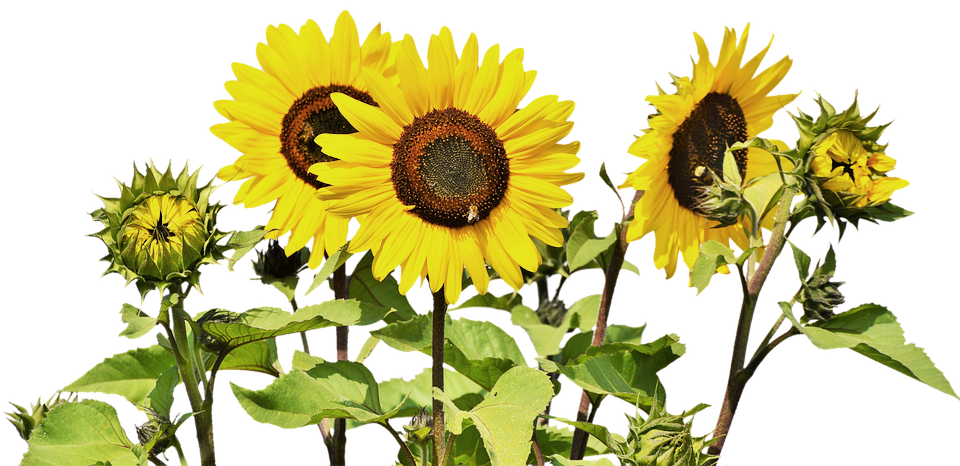
Growing Herbs Indoors & Out
By Chris Edmunds
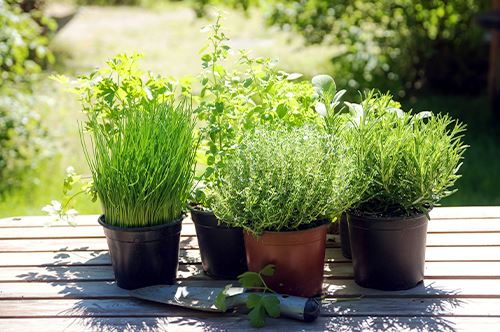
Enthusiasm for growing herbs has increased in recent years and is a healthy trend we absolutely love! Herbs are an excellent way to add beneficial antioxidants to your meals and reduce the need for salt to increase flavor. Another benefit is that their strong fragrance makes them virtually pest-free in the garden!
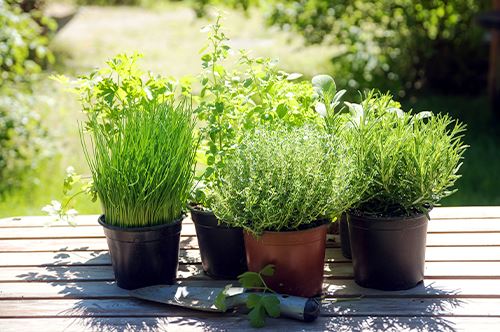
Anyone can grow herbs, even a beginning gardener. Here's a list of versatile herbs that will grow well in our area. We've split them up into categories based on how they grow.
An important thing to keep in mind when choosing herbs is to replicate their natural environment, whether you plan to plant your herbs in pots or in the ground. Before we get into the specific herbs, here are 3 essential care tips:
- They all need drainage, so plant them in soil that drains well.
- They all need sunshine, upwards of 6 hours a day. Placing them outside or near a south-facing window is best. You may need a grow light in winter for indoor growing.
- They benefit from being harvested. Cutting sprigs just above a set of leaves will encourage branching from that point. Do not pull individual leaves directly from the plant.
Perennial Herbs
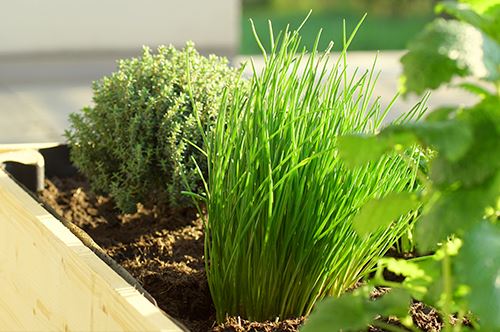
Chives are definitely one of the easiest herbs to grow. They come back year after year and spread in the garden. They have beautiful edible flowers, and they add a lovely kick to your food. Chives will also grow happily in a pot with good drainage. You can cut chives right down to an inch above the soil, and they'll send up new shoots.
Indoors, keep them near a sunny window. Chives like to dry out slightly between watering. If you want chives all year long, keep 3 or 4 small pots of them, so you can harvest them in cycles and give each pot some rest time to regrow.
Garlic chives are similar to grow, add a mild garlic flavor when used, and offer beautiful white star shaped flowers late in the summer.
Mint is also an easy herb to grow in indoor pots or your outdoor containers. In your garden beds, it will spread like crazy and take over! Barriers can be put in place but will need to reach a depth of one foot in order to keep mint from spreading. It will be happy in a pot with good drainage. It likes to dry a bit between watering as well but keep an eye on the leaves. If they start to look a little crispy, your mint needs water.
Mint can get lanky, so harvesting sprigs regularly will keep it looking tidy. If you see flowers, pinch them off to encourage more leaf growth. You can cut mint back a lot without damaging the plant, so if you need to make mojitos for the whole neighborhood, it will keep putting out new growth.
Catnip and Lemon Balm grow similarly to mint but are better behaved when planted in the ground. They stay in clumps instead of spreading like mint, but they do sometimes reseed themselves so you may end up with a larger patch over a few years. They, like mint, are excellent choices for indoor growing as they can tolerate more shade than most herbs. Try using them as a calming tea. Catnip isn’t just for your feline friends, though they do get much more excited to have it as a treat.
Thyme is a highly versatile herb both in the garden and in the kitchen. We offer a few varieties with distinct flavors like lemon, spicy orange, and a traditional French thyme, as well as, creeping thyme that has less flavor but makes up for it with a spreading habit with striking flowers. Thyme also likes to dry between watering. It can be harvested as needed but will have the most flavor when cut just before the flowers open.
Oregano is also regularly used in many styles of cooking making it a must-have for a kitchen garden. Also, happy in dry heat of the central plains it is easy to grow outdoors. Indoors it needs lots of light and regular trimming to stay happy.
Annual Herbs
Rosemary is ideal for a rock garden outdoors, or a well-draining pot. Like most Mediterranean herbs, rosemary does not like wet feet so provide good drainage and air circulation. You can harvest up to 1/3 of the plant at once, but it will need a fair bit of time to regrow before you take more. Rosemary does not like cold drafts, and it needs lots of light and heat.
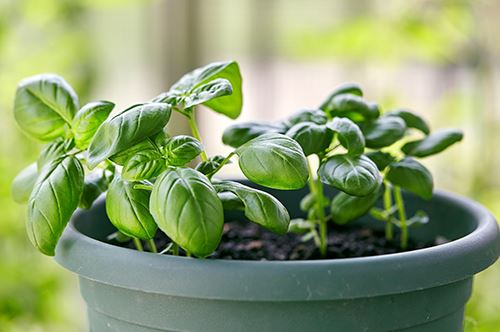
Basil is a must have if you are a tomato lover, said to improve the growth and flavor when planted together. It can be finicky when there’s not enough air circulation, or wet conditions persist. Indoors, basil plants need at least 6 hours of warmth and sun and excellent drainage. Outdoor basil needs protection from the cold, but it thrives in heat.
Harvest basil when there are 6-8 leaves on a stem. Cut the stem right back to just above the lowest set of leaves to encourage branching. If you see flowers, clip them off as soon as you can as the leaves will lose flavor when the plant is flowering.
Lavender* has become the new darling of the herb world, but it can be one of the hardest herbs to be successful with. We’ve tried many varieties and offer only the ones that proved to be better than the rest, but even those have special needs. All lavenders hate to have wet feet, so only water when you know the soil has dried out. Be sure to use soil that has excellent drainage, adding pebbles to the bottom of a container can help. Good air circulation is also needed, as they dislike high humidity, so be sure to give your plants plenty of space to grow.
*There are a few varieties of lavender we carry that would be considered perennial, Phenomenal, Munstead, and Hidcote. They are an English type and are hardier than other varieties.
Parsley is easy to grow both indoors and out. Flat leaf parsley is the most common for culinary use. Moss curled is used more for a garnish and does add a beautiful texture to containers. It requires more water than most herbs so keep an eye on it in hot dry weather. Harvest by cutting 2 inches above the soil leaving the young center leaves to regrow.
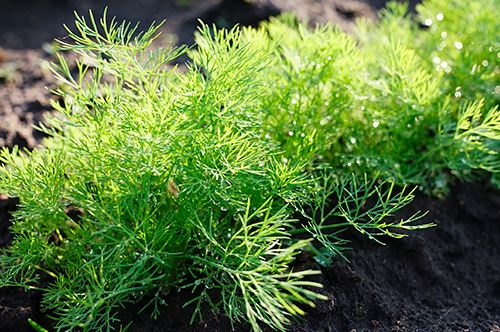
Dill can be a large plant and needs lots of space, but we offer a compact variety that is an All-American Selections Winner, making it suitable for small spaces and containers. You can harvest dill once it's about 6 inches tall. Dill seed heads make really interesting additions to floral bouquets and add a more robust dill flavor to pickles. Once they go to seed, they will begin to die as they have completed their lifecycle.
Both dill and parsley are host plants to swallowtail butterfly larva, which will feed in the midsummer devouring plant leaves. By planting a few extra plants, you can encourage these pollinators and still have a decent crop for yourself.
Cilantro/Coriander is a cool season herb that is used for both its leaves and its seeds. It is a bit more difficult to grow in our area than other herbs simply because increase in temperature causes it to go to seed. This is great for those who wish to use it for its lemon-sage flavored seeds (coriander). If growing cilantro for its leaves, it is a good idea to place in an area where it is protected by the hot afternoon sun and having a few plants so you can harvest them in cycles and give each some rest time to regrow. To harvest, cut the plant back to about 2 inches leaving the smallest leaves at the center of the plant to regrow. If the center begins to grow tall fast, and the leaves become more fern-like, it is trying to go to seed.
Harvesting herbs early in the morning will have the highest oil content and therefore better flavor. Most can be harvested as needed but most are going to be the most flavorful right before the flower buds form, with the exception of some basils and cilantro which may lose flavor if allowed to begin flowering. Perennial herbs do not require much fertilizer adding to the ease of maintenance, annual herbs like cilantro, basil, dill and parsley could benefit from a high nitrogen fertilizer (the first number in the three-number system N-P-K) which encourages leaf growth.
If you want to give growing herbs a shot, stop by one of our seasonal locations. Our staff can show you the array of herbs we grow, so you can start adding the fresh flavors of summer to your recipes all year long.

